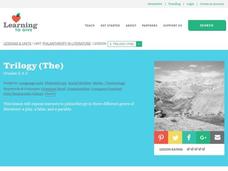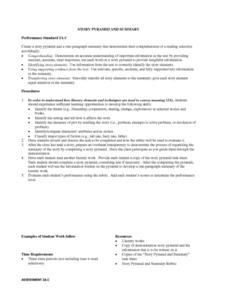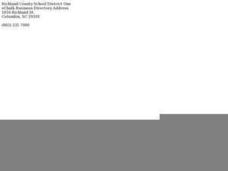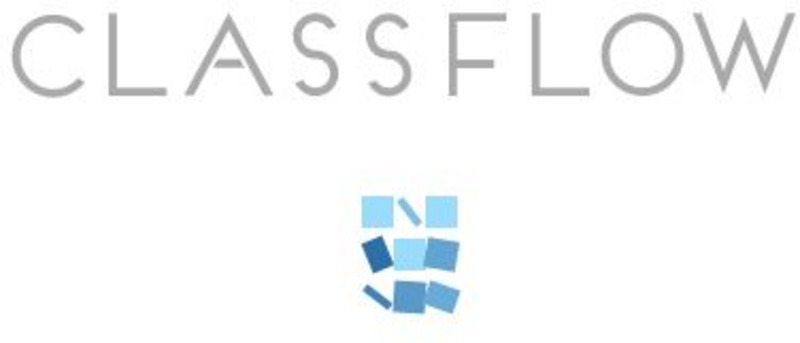Curated OER
Critical Thinking With Fables New and Old
Explore the fables of today along with Aesop's ancient fables. Learners will understand the structure of a fable, critically think about the fable's message, and create a lesson plan that they would like to teach through a fable....
Curated OER
The Coin and the Fable: Alaska quarter reverse
An Alaskan quarter and a book of fables is what you'll need to start this activity. Learners will use the image of the bear and the salmon found on the reverse side of the Alaskan quarter as inspiration. They will compose a fable about...
Curated OER
What is a Fable?
Students read a variety of electronic Aesop's fables to define fable and moral, and write and illustrate an original fable. They then publish their fable using PowerPoint.
Curated OER
Writing Fables
Students develop a working skill of using graphic organizers for writing. The instructional activity notes that the best kind of organizer is one that is engaging to the appropriate audience. The assessment follows the rubric given in...
Curated OER
Fable Writing
Students listen to and discuss various fables, and identify the moral and central themes. They write their own personal fables and create illustrations to go with them.
Curated OER
Lots of Lessons from Aesop
Aesop’s Fables offer young learners an opportunity to study figurative language. After reviewing theme, simile, alliteration, and metaphor, model for your pupils how to identify examples of these devices in the fable. Class members then...
Curated OER
All About Aesop
First graders explore the genre of fables. In this fables lesson, 1st graders use various reading strategies to raise comprehension skills. Students make prediction and complete a prediction journal. Students understand that fables have...
Curated OER
Nibble, Nibble, Little Mouse
Students complete activities to analyze points of view in different texts. In this point of view lesson, students read Hansel and Gretel and The Magic Circle and discuss the points of view. Students choose a character from the story and...
Curated OER
Writing Own Tale
Third graders read The First Strawberries and complete a character chart. In this writing a tale lesson, 3rd graders discuss viewpoints and identify character traits. Students complete character charts and write their own tale about...
Polar Trec
Talk Story: A Native Way of Knowing
The steps of the scientific method examine a problem, make a prediction, and attempt to solve the problem—similar to the path most stories take. In the activity, individuals see how stories can explain natural events similar to the way...
Curated OER
Scrapbook of Evidence
Students read three different genres of fiction. They create a story map and brainstorm possible collage inclusions. Each student prepares a minimum of two scrapbook page entries for each text or passage. Students write beside each...
Curated OER
Personification Stories
Students create a clay object in which they are to personify. They use their own personal experiences to help the viewer imagine what it would be like to be that particular object. They also watch videos of fables to help them with...
Curated OER
Philanthropy in Literature
Students research philanthropy in three genres: a play, a fable, and a parable. Students read an Aesop fable and answer questions in groups. Students complete steps in two worksheets from 'The Good San Franciscan' and 'Someone Should.'...
Curated OER
Newspaper Writing in Various Genres
In this newspaper writing in various genres worksheet, students create 8 newspaper articles in different genres (list provided), following the examples given, with grading rubric included.
Curated OER
Story Pyramid and Summary
Students read a short selection of a story individually or as a class. On their own, they create a story pyramid for the selection and write a one page summary. They use text from the story for their supporting details. To end the...
Curated OER
Tell Me a Whopper!
Sixth graders investigate tall tales as a literary genre. They listen to a number of tall tales to discover how exaggeration is used as a story element. They write and publish a tall tale using word processing software. They illustrate...
Curated OER
Bunyan, Appleseed, and More
Ninth graders listen to a variety of tall tales and compose their own tall tale. In this tall tale lesson, 9th graders complete KWL chart about tall tales. Students discuss the elements of tall tales and then read example tales....
Georgia Department of Education
Ga Virtual Learning: Traditions: Book of Wisdom Project Rubric [Pdf]
This one-page PDF is a rubric for the "Book of Wisdom Project," which requires students to write two original fables and locate and compile a list of proverbs/sayings, catagorize and illustrate them, and write about the authors. Search...
Georgia Department of Education
Ga Virtual Learning: Traditions: Book of Wisdom Project [Pdf]
This is a one-page PDF outling a Book of Wisdom project which requires students to write two 300-500 word original fables with all of the characteristics of a fable including a moral or lesson. The second part requires students to find...
ClassFlow
Class Flow: Fabulous Fables
[Free Registration/Login Required] This flipchart reviews the characteristics of a fable, gives some history of Aesop with a video clip. Student assessment questions and web links are included. Students end with an original writing...
Other
Storytelling to Assess Speaking and Listening
An effective use of rubrics that encourages the student storyteller how to determine if his/her audience is listening. Learn about the different listening skill rubrics, storytelling rubrics and a self-assessment guide that asks the...
Science Education Resource Center at Carleton College
Serc: Investigative Case: Protistan Tales of Atlantic White Cedar Swamps
A WebQuest where learners explore microbial diversity by looking at the extreme habitat of the Atlantic White Cedar Swamp. Students will learn about protists through personification theme of Aesop's Fables. At the end of the lesson,...



















![Ga Virtual Learning: Traditions: Book of Wisdom Project Rubric [Pdf] Rubric Ga Virtual Learning: Traditions: Book of Wisdom Project Rubric [Pdf] Rubric](https://d15y2dacu3jp90.cloudfront.net/images/attachment_defaults/resource/large/FPO-knovation.png)


